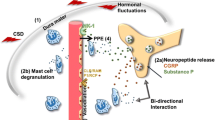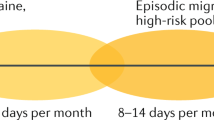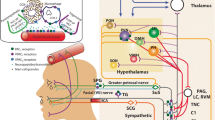Abstract.
The headache in migraine is thought to result from neuronal nociceptive activity in the trigeminovascular system, that is, the meninges. In addition, trigeminal axons projecting to the meninges contain vasoactive neuropeptides, such as substance P, calcitonin gene-related peptide and neurokinin A, that may promote, when released, plasma protein leakage and vasodilation within dura mater, characteristic of neurogenic inflammation. Thus, it has been hypothesized that a sterile neurogenic inflammation in the meninges may be involved in generating or sustaining, via occurrence of a vicious cycle, the pain accompanying the migraine attacks. We here review the evidence in support of this hypothesis as well as its potential significance in better tailoring therapies in migraine or other types of primary headaches.
Similar content being viewed by others
Author information
Authors and Affiliations
Rights and permissions
About this article
Cite this article
Fusco, M., D'Andrea, G., Miccichè, F. et al. Neurogenic inflammation in primary headaches. Neurol Sci 24 (Suppl 2), s61–s64 (2003). https://doi.org/10.1007/s100720300043
Issue Date:
DOI: https://doi.org/10.1007/s100720300043




